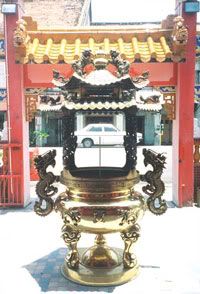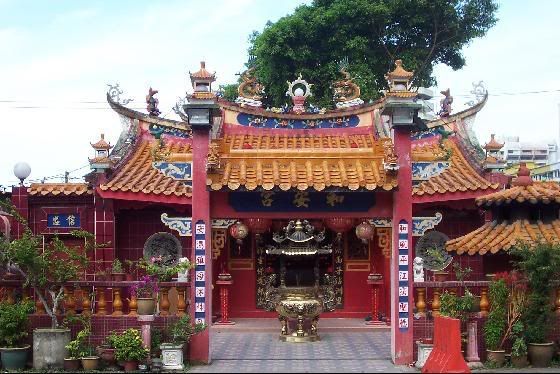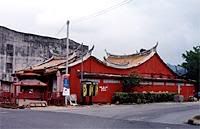Kampung Cina

Foreword
Kampung Cina literary mean Chinese Village and are also called Little Chinatown by foreigner.
Kampung Cina is one of Southeast Asia’s most enchanting early Chinese settlements in the world heritage where amidst colour and clutter, one can discovers stately ancestral homes, temples, townhouses, and sundry shops
Most of the description that were given out to tourist was not correct and wasn’t lengthy or deep enough and sometime non sequitor. Most of the info about Terengganu,Kampung Cina only cited only a few thing which made many people think that Kamp ung Cina is just a 200 year old Simple town .A small town section with no or litter significant other than just tourist attraction while visiting Kampong Cina
Here some of the “thing”, which are usually cited in magazine and Tourism brochure including the many tour agency website in or out of Malaysia.
“A row of 200 year old prewar old building at Jalan Kg Cina. –build by the Chinese from China –arrived in Peninsular Malaysia in the 19th century. -2 stories, with brick or concrete structure and wooden flooring in the second storey. -its wood carving on the windows and huge heavy wooden front door - some were turned into the renewed modern concrete building.The century old building are now sundry shops, local coffee shops, offices for several tour operators, batik and souvenir shops, restaurants etc..
The 200-year-old shop houses along the banks of Sungai Terengganu and the Kampung Cina’s various historical structures such as the Low They Well, the 200-year-old bridge ,Chinese Temple painted in red colour standing at the corner and the Snake Temple are gazetted as a heritage site since 2004. It is said to be one of the well preserved Chinatown Southeast in the world. In fact, it is included Unesco's heritage listing.”
N.B:
Well actually they are a very long story of it which I compile here about Kampung Cina which is now a Terengganu heritage and the fact that it is one of Southeast Asia’s most enchanting heritage site for early Chinese settlements in world .
Almost all the info about Kampung Cina Was taken from: e-terengganu.com
Anyway, I make some “edit” to the article .The Original article can be found in the link that can be found at the lowest bottom.
Kampung Cina , Chinatown of Kuala Terengganu is the main Chinese settlement in Kuala Terengganu , situated near the heart of Kuala Terengganu city centre. In 1719 , the Chinese village settlement had more than 1000 house compared from its today row of pre-war Chinese shop houses of that which only dated as far as 200 year or its earlier dated that are recoded by foreigner like Alexander Hamilton and Captain Joseph Jackson who visited the Chinese settlement while in the Kuala Terengganu town during 1719. and other like J. Newbold in 1893, Munshi Abdullah in 1836, and more.
But the exact date of the founding of Kampung Cina is not clearly know as no archaeology dig was ever made, as to preserve the Kampong Cina site which is now a part of the city. Many who live here can be say are decendent from the first Chinese who arrive and settler here at Terengganu since the 16th.century.Thus many of it occupants treat they house as ancestral home which have many history of being handed down from their father to their children and grand children.
On the year 2004, The Government had declared that the Kampung Cina’s various historical structures and area was gazetted as a heritage site of Terengganu.
Some record of the early presence of Chinese settlers in Kampung Cina
When Alexander Hamilton and Captain Joseph Jackson visited Kuala Terengganu in 1719-1720 and 1764 respectively, the presence of Chinese settlers was noted down in their records. Alexander wrote: " Trangano ........ about one thousand houses in it, not built in regular streets, ....... The Town is above half-peopled with Chinese, who have a good trade for three to four Jonks yearly, ....... The product of the country are Pepper and Gold, which are mostly exported by the Chinese. About 300 tons are the common Export of Pepper, ........".
According to the Malay scholar Munshi Abdullah who visited Kuala Terengganu in 1836, there was a large Chinese quarter with a Kapitan Cina (Chinese leader) named Kapitan Lim Eng Huat (1798-1847), who was the third Kapitan of Chinatown. He probably saw the concrete bridge being built during Sultan Mohammad's period (1837-1839) because in his second visit here, Munshi wrote about the bridge in 1838.
Kuala Terengganu was also described by T.J. Newbold in 1893: "...... the Malay town of Terengganu in 1828 was large and populous .... The Chinese are numerous, and live principally in strong brick-built houses, which now exhibit every appearanc e of an old and long established colony. The Chinese population of the town is estimated at 600, that of the Malays from 15,000 to 20,000".
Various Chinese records and annals - dated as far back as the 10th century (Song Dynasty) have referred to the ports of Terengganu. Javanese records of the Kingdom of Majapahit in the 14th century also placed Kuala Terengganu on their list of trading centres. But no one really know the exact dated of the Chinese settlement in Kampung Cina. It is only certain with evidence that the Chinese settlement may started in Terengganu after Admiral Cheng Ho (Zheng He) of China return back to China between 1419AD to 1719AD or maybe before or around the time of Alexander Hamilton and Captain Joseph Jackson who visited Kuala Terengganu in 1719-1720.
.
It is believed that Admiral Cheng Ho (Zheng He) of China - the Goodwill Ambassador of the Ming Dynasty - led a huge fleet of about 200 vessels with approximately 28,000 marine officers and crew to the shores of Kuala Terengganu in the year of 1414 A.D. This is based on evidence from a map of places visited by Cheng Ho, during his fourth trip to the west.
Right after the visit of Cheng Ho/ Zheng He, Chinese farmers from the coast of China, especially the people from Zhangzhou District of Hokkien Province sail to Terengganu first settled at Bukit Datu (Big City), and along the river bank of Sungai Nerus. The Chinese’s forefathers in Terengganu named Sungai Nerus as Sampokang (Cheng Ho's River) and built a temple at Kampung Jeram - Sampokong Keramat Cheng Ho.
By the mid-1800s, with the booming of the Tin Mining and industries, the Chinese population of Kuala Terengganu and the whole Malaya increased tremendously as new Chinese immigrants arrived here for work. Kuala Terengganu, which is strategically located on the east coast of Peninsular Malaysia, was a natural stopping point for those who plied the trade route from China to South East Asia in the early days. Those who fall in love with this enchanted land simply stay on while the rest, sail on to fulfil they own destiny, in places like Perak and Kuala Lumpur for tin mining. Kampung Cina became the most densely populated area for the Chinese community in Kuala Terengganu.
---------------------------------------------------%^&^%----------------------------------------------------------
Kampung Cina the Chinatown of Kuala Terengganu.

Today, a stroll along Chinatown from the Kampung Cina .Arch as the commencing point one has a nostalgic feeling as if he is stepping back into time. Two rows of 236 shop houses with many which dated back to the late 1800s flank the road. One of the row of shop houses is built along the riverside on the right side of the mouth of Terengganu river. Many of these shop houses have extensions to as far back facing the river. In the early days, the river was the essential mode of transport. Some of these extensions date back to times when the riverside shop houses had back entrances and jetties for loading and unloading goods from boats. Today, at the back of some of these riverside shop houses are jetties where speedboats dock.
At the back of the other row of shop houses you will find a hawkers selling various types of economic local food both Malay and Chinese. An old Well, which dated back more than a hundred years is also located nearby. It is known as the Low Tiey Well. During the early settlement days, the term Low Tiey meant both that of Chinese translator and Chinese community leader (e.g like Capitan). The water in the well was used for drinking and washing. The well was also believed to have been excavated and constructed in 1875 by Low Tiey Lim Keng Hoon (1820-1882).
Chinatown has been acclaimed as a part of Malaysia's living history of shop house a rchitecture, revealing a spectrum of architecture from the earliest wooden and Baroque, to 1920s Art Deco and post-Modernism all on one street. Many of the Chinese in Chinatown are the descendants of the early settlers. Till today, signboards on shop fronts prove that many of these families still live here - namely the Wees, Lims, Tans, Teos and Phuahs. You can see many Chinese characters carved on the antique Doors and Panels around here. Shop house No. 177 of “Jalan Bandar” is the "generation" home of Madame Teo. The shop house - Chop Teo Lian Hin - is today better known for its Durian Kuih (durian cake), Pulut Panggang (roasted glutinous rice) and Keropok (fish crackers) which Madam Teo makes for sale. There are many more local delicacies such as Roti Paong (small Chinese bun or bread ), CimKuah (crab cake), and Satay (sweetened roast meat) available for sale along this old Chinatown s treet. Restoran Sin Pin Siang (Ah Hong Coffee Shop) serves breakfast which includes a choice of the delicacies mentioned above. There are also several other reasonably-priced restaurants such as Restoran Chen Chen, Restoran Chan Wah Loi, Restoran Guan, Restoran Golden Dragon, Restoran Sik Wai Sin, Restoran Ho 183, Kedai Makan Soon Kee, Restoran Teck Lai, Kopitiam Cappuccino and Chef Pa Pa.
At the old Kampung Cina in Kota Terengganu.can be found the some Hui family (Pure and original practicing Muslims who came from China and are not a mualaf ) and the last vestige of the Chinese Muslim heritage in Terengganu. At one end there was a Chinese temple, at the other end a mosque. On this street there used to be 4 Chinese Muslim shops, selling books, medicine, and other miscellaneous goods. Two of the shop is a laundry shop which sold rice another one is a bookshop. Kedai Buku Al-Yunani. when the owner passed away, the sons operated it, and it became the most famous shop for religious books for a few decade.. After the son passed away his brother took over, and later passed it on to his Malay so n-in-law. Regrettably that the shop, under the new owner, has done away now with its famous name, and with it, its Hui identity. Today it still stands there but the name is Alam Akademik Sdn. Bhd. So the last vestige of the Chinese Muslim heritage in Terengganu has thus come to an end.
In Terengganu there are many Hui descendant who is totally assimilated into the malay culture after many intermarry in generation that they didn’t realize of they Chinese Hui descendent and origin. Similar to the original Hui (Chinese Muslims) from Zheng He’s time that live in Bukit Dato and along the river bank of Sungai Nerus near Sampokang (Cheng Ho's River) and the temple at Kampung Jeram - Sampokong Keramat Cheng Ho.
A visit to Kampong Cina can be a place for many Muslim and the Hui to trace back some of the Terengganu Chinese Muslin heritage like the Al-Yunani Family or Hui or Orang Yunnan as the local Malay used to call them.
if u wish to know more of the Hui
(http://www.islam.org.hk/eng/malaysia/ChineseMuslim_in_
Malaysia. asp#Early %20presence%20of%20Chinese%20Muslims%20 –%20Zheng%20He,%20the%20Muslim%20Eunuch )
Further down the road and past the old brick bridge is shophouse No. 53. It is one of the earliest brick homes in Chinatown, constructed by builders from China who were commissioned by Wee Beng Siang, a revenue farmer and the great-grandfather of the present landlord Dr. Wee Tiong Wah.
---------------------------------------------------%^&^%----------------------------------------------------------
The Chinese Temple of Kampung Cina



Two very old Chinese temples - Ho Ann Kiong (1801 A.D.) [left] and Tien Hou Kong (1896 A.D.) [bottom]- are located in Chinatown. Other than being places of wors hip, the temples were also community centres for the Hokkiens and Hainanese respectively, and temporary shelters for the early immigrants.Tien Hou Kong or Guanyin Bodhisattva is Buddhism Religion that are found in the Year 1738 in China

Further down to the end of Jalan Kampung Cina is the Central Market - or Pasar Besar Kedai Payang - where various fruits, vegetables, textiles, household goods and sundry items are displayed for sale. The atmosphere in Chinatown is one of familiarity and informality. Walking along it feels like being back to the simple days of yesteryear.

Here you will find the colourful long roof has created a unique and beautiful photographing spot for photo taking especially in evening before the sun disappears from the sky.
This is why its is important to preserve any historical site.
With Kampung Cina's potential as a tourist attraction, any infill development in the town should be in harmony with its existing structures in order to preserve the historical ambiance of Chinatown.
Tips in Kampung Cina.
In Kampung Cina , you will find many thing; from a Super,,,,Er I mean a Supermarket (The Store-The largest chainstore of Supermarket-chum in Malaysia), a wine shop , ( the exact place where the Ho Ann Kiong Temple picture got taken ). Dont miss the Chinese Small Peddler and Trader Centre or “Siow Fang” next to the “super”, here you find a lot of Chinese eatery (where you can eat till you drop or buy your greengrocery, dumpling, flower, cloth,Craft and Jed)
Beside that you can find the most delicious Chinese curry noodle or “Kari Mee” in Terengganu.(When you get out of the main Door at “The Store” ,look right .walk across the road, You will find a wooden stall with many customer-Beware very spicy!!- .
Infront /across the Kari Mee stall, you will see a peddler selling Chinese ground Soy Drink and many thing “kueh” (The best motorcycle drink stall in Kampung Cina and most warm hearted person in Kampung Cina.)
N.B.or nota bene
There is a hotel in Chinatown called Hotel Seri Malaysia built on the land of the former Malay farm Market - Kedai Binjai. the development of the Hotel Seri Malaysia branch, at the main entry to Kampung Cina was it was a blessing to provide more accommodation to tourist in Terengganu and was also protested by many people .Why? Because a decade ago, people could enjoy the view of Sungai Terengganu and the many colourfully light emitted by the many fisherman boat at night from Kampung Cina and also to do some fishing, "Now, due to Seri Malaysia, their view is blocked
Several tourist agencies such as , No.200 & 202 Square Point Resort (Lang Tengah), No.139 Redang Bay Resort, No.181 Redang Holidays, No.167 Redang Reef Resoretc are located in Chinatown.
There are also other shops -Batik Flaz, Teratai Arts and Crafts - selling souvenirs ranging from batik cloths to antiques. Similar shops can also be found at the Central Market.
most of the Info are taken from link below and for more reading please go to:
http://www.e-terengganu.com/chinatown
http://www.islam.org.hk/eng/malaysia/ChineseMuslim in Malaysia.asp
http://www.american.edu/ted/malacca.htm







8 comments:
Thank You on your article.I didnt know that thre are more to kampung Cina when i went there last Year...
Next time i definently going to show this articleto thenm next time
Jack,Texas (Proud To B One)
The Chinese food sold in Kg.China is nothing to shout about. The good Terengganu Hokkien food is always home-cooked.They are kay hong,kay char yiam, chim kuih,bak wan,ngor hiang tiau. Oh too many to name all.
yes I agree with anonymous...the food sold in kg china is nothing to shout about ...there are kay hong' chim kuih, pulok lipa, pa chauk and other long lists to come.Some of the recipe in the nyonya articla isn't completlely authentic
thanks for this nice post 111213
thanks for this tips
I’m a Malaysian of mixed Chinese Hokkien and Madhya Phradesh parentage. According to my maternal grandma, the Chinese side of me descends from Marang, eventually meeting up with Malacca Nyonya Babas and moving on to Taiping whence my paternal history begins, with my great grand father , a"Christian Brahmin" from India.
I have yet to visit Marang, perhaps this year and will write about this "Roots evaluation" soonest.
Thank you Marang.
There are not many Chinese still living in Marang area, as most have opt to move to town area. There are actually more of Mix Chinese , then Chinese still live in Marang. As most have totally assimilate to Malay culture after a few generation of Marriage..
Post a Comment